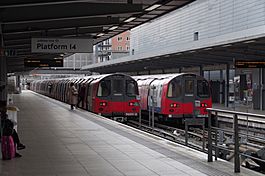Jubilee line facts for kids
Quick facts for kids Jubilee line |
|
|---|---|

Jubilee line trains at Stratford, the eastern terminus (2014)
|
|
| Overview | |
| Stations | 27 |
| Colour on map | Silver |
| Website | tfl.gov.uk |
| Service | |
| Type | Deep Tube, sub-surface |
| System | London Underground |
| Depot(s) | Neasden, Stratford Market |
| Rolling stock | 1996 Tube Stock 7 carriages per trainset |
| Ridership | 213.554 million (2011/12) passenger journeys |
| History | |
| Opened | 1979 |
The Jubilee line is a special train line in the London Underground system. It travels across London, connecting Stratford in the east to Stanmore in the north-west. This journey takes you through important areas like the Docklands, South Bank, and the West End.
It first opened in 1979, making it the newest line on the Underground. Even though it's new, some parts of its tracks and stations are much older. Some sections of track date back to 1932, and some stations were built in 1879.
Newer stations on the Jubilee line are bigger and have special safety features. These designs help make sure the line stays useful for many years to come. After the line was extended to east London, it became much easier for people in those areas to use the Underground. This led to a huge increase in passengers. The Jubilee line is now the third-busiest line, with over 213 million journeys in 2011/12.
Contents
History of the Jubilee Line
The Jubilee line officially opened on 1 May 1979. At first, it ran from Baker Street to Stanmore. A new four-kilometre section was added into central London, ending at a new station called Charing Cross railway station.
The Jubilee Line Extension
A big expansion, called the Jubilee Line Extension, opened in three parts during 1999. This extension branched off from the original line at Green Park. It created a new route that went further east. The old one-station branch to Charing Cross is now closed, but it is sometimes used for filming movies.
With this extension, the Jubilee line became the only line on the London Underground that connects with every other line. This makes it a very important route for getting around the city.
Night Tube Service
On August 26, 2016, Sadiq Khan, who was the Mayor of London at the time, announced an exciting change. The Jubilee line would start running trains all night on Fridays and Saturdays. This 24-hour service began on October 7, 2016, making it easier for people to travel late at night.
Special Features of the Line
The stations that were built as part of the Jubilee Line Extension have some cool features. These include:
- Easy access: You can get from the street level to the trains without using stairs. This is called step-free access.
- Modern design: The stations have a very modern and interesting look.
- Safety doors: There are special doors at the edge of the platforms.
Platform Edge Doors Explained
The platform edge doors are important for several reasons. They help to control the air flow underground and prevent strong winds. They also stop people from accidentally falling or jumping onto the tracks. Plus, they help keep the tracks clean by preventing litter from blowing onto them.
Why is it Called the Jubilee Line?
The Jubilee line is shown in silver on the Tube map. This color and the name were chosen to celebrate the Silver Jubilee of Elizabeth II. This was a special event in 1977 that marked 25 years of Queen Elizabeth II being on the throne.
Images for kids
See also
 In Spanish: Jubilee Line para niños
In Spanish: Jubilee Line para niños



